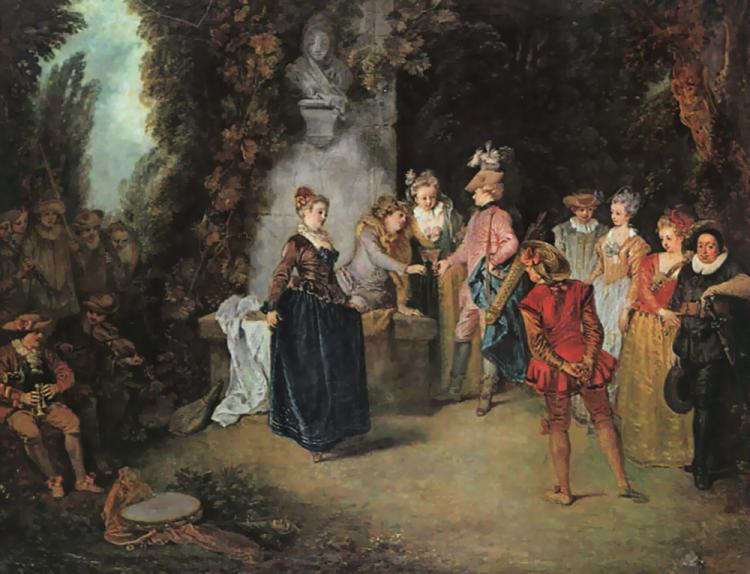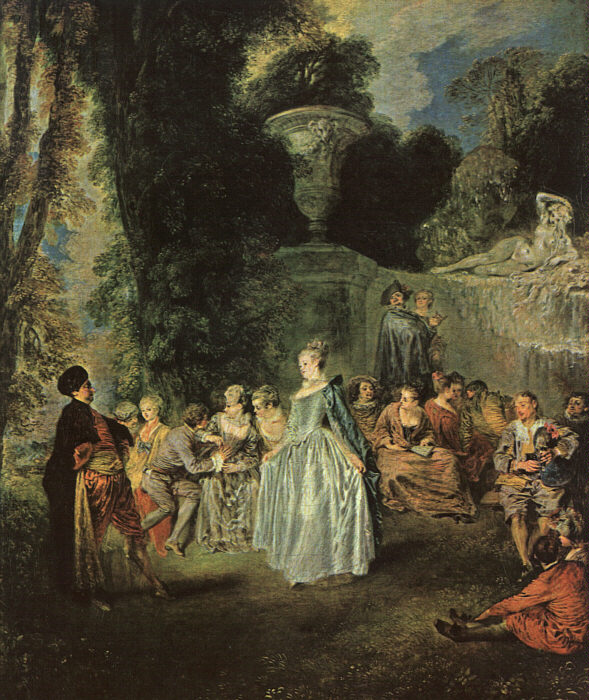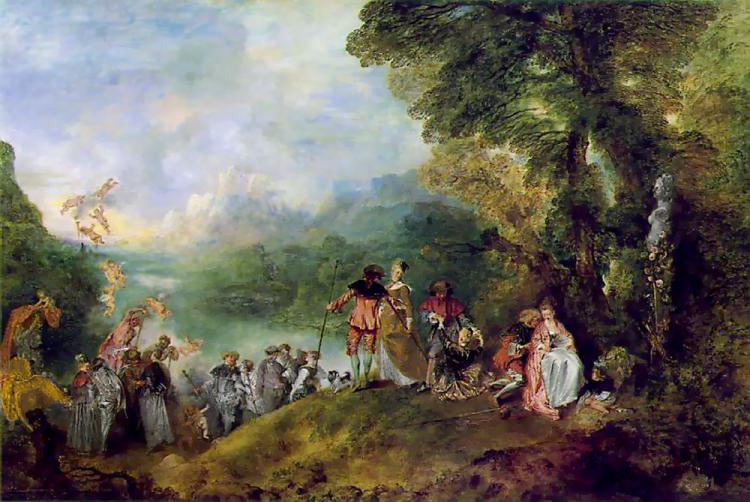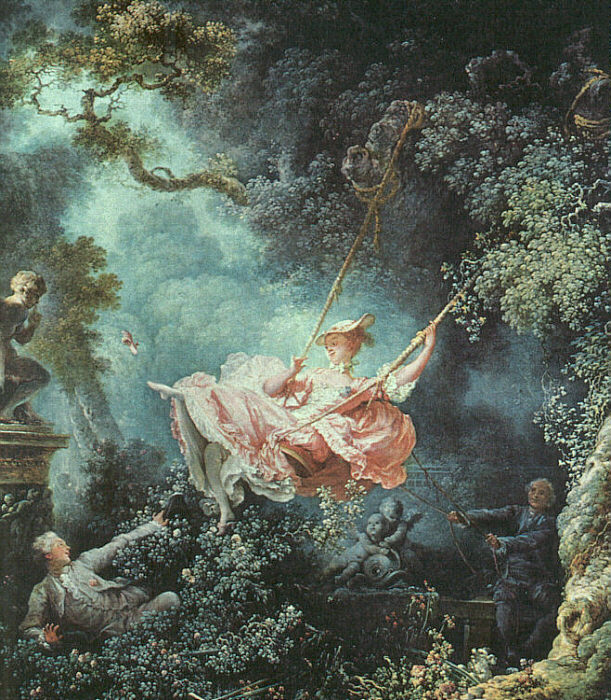
|
|
|
|
|
|
|
|
|
|
|
|
|

From 1590 – 1700, Baroque art dominated European art. The French artists Nicolas Poussin, Charles Le Brun and Jules Hardoin-Mansart exemplified the Baroque style of art and architecture in France. Under Louis XIV, Le Brun helped design the Palace of Versailles, while Mansart later added the Galerie des Glaces or Hall of Mirrors (Adams 660-662). Poussin’s work combined Baroque and Classical styles, and he is most well-known for his series on the life of Phocion, a fourth-century B.C. Athenian politician (Adams 702). Although the death of Louis XIV is usually regarded as the end of the Baroque period, some art historians regard Rococo as simply an extension of that period. Poussin and Peter Paul Rubens, another Baroque artist, continued to influence artists to come; however, there are fundamental differences between Baroque and Rococo art that establish Rococo as its own phase in art history (Janson).
When Louis XIV died in 1715, Louis XV was only five years old, and by the time he was installed at Versailles as King of France he had gained a reputation as “intelligent, cultured, great lover of the arts,…essentially a lover, and nothing more” (Palacios 8). The death of the “Sun King” relaxed the obligations of the French aristocrats, many of whom moved back to Paris to live in their hôtels, elegant town houses, which needed intimate, delicate interior decorations (Janson). The change in ruler also caused a change in patronage. Royalty was no longer the main commissioner of art; that responsibility now lay with the aristocrats and bourgeoisie (Adams 706). These changes in use and patronage, along with shifts in social and moral paradigms, shaped the art of the early 18th century.
As Louis XV took over as King of France the attitudes of French society changed. Strict piety was no longer as important and pleasure was emphasized more than power. Although the aristocracy was still a main component of the triangle of power, the bourgeois class was beginning to emerge and the church was receding farther into the background. As Enlightenment ideas gained in popularity, women played larger roles than before, although they still did not have many rights or privileges. Rococo art reflected some of these ideological shifts. With the relaxation of moral standards came more erotic paintings; some paintings were overtly sexual while others remained subtle. The Rococo artists, especially Watteau, focused on aristocratic subjects and deemphasized religion, reflecting the shift away from the Church as a patron. Enlightened aristocratic women began holding salons to facilitate and promote conversation and the spread of Enlightenment ideals. As women began to influence other aspects of society, the paintings became more feminine and lighthearted.

In subject and in style, Rococo art reflected these changes in society.
Frivolous subjects reigned supreme and featuring aristocrats and mythical
subjects became the focus of French painters. For example, Watteau’s painting
Fête
venitienne (pictured at left)
depicts French aristocrats in an idyllic garden setting. The nude statue
in the background adds an erotic sense to the painting as well as an allusion
to nudes from famous paintings of the past. Boucher focused on mythical
subjects, including his famous work Venus Consoling Love of 1751.
Fragonard’s The Swing represented a deliberate depiction of an erotic
subject, as it was commissioned by a courtier specifically with the intention
of provoking erotic ideas (Jarasse 92).
The style employed by Rococo painters also reflected the tendencies of society. Rocaille, meaning “rock,” and coquille, meaning “shell,” combine to form the name of the style, and are used because rocks and shells were often used to decorate gardens and were then portrayed in the paintings of the time as well (Adams 706). A departure from the dramatic contrasts of light and dark found in Baroque art, Rococo featured shimmering pastels. To form a light blue color, for example the color found in the dress of the dancer in Watteau’s painting, the painter began with an underlay of a pearly white, opalescent color. He would then add thin layers of blue and top it with white highlights. This technique allowed for visible brushstrokes, another difference between Rococo and Baroque, and gave the paintings a sense of texture.
In The Idea of Rococo, Park explains the fundamental differences between Baroque and Rococo, the reason why Rococo is not considered just an extension of Baroque:
For on the one hand, as Wolfflin defined it, rococo continued the amorphousness, the blurring of contours, the breaking up of forms, their dissolution in the magic spell of light, the fluidity, the softness and suppleness of baroque, but on the other hand, it carried the baroque so far that it became subversive and destroyed the illusion, the epiphany, and the overarching hierarchy upon which the baroque depended (Park 16).Beyond color, some characteristics of Rococo art include S-curves, C-curves, shells, mosaic, bat wings, falling water, miniaturization and asymmetrical cartouches (Park 17). The figures portrayed were dressed in fashionable clothes with slim head, throat and feet, and were set in rural scenery (Geitman). Painters defined their figures using color, as opposed to drawing them in first, which appealed to the senses, also important in this era of frivolity (Janson). Rococo art also emphasized that all moments are equal and the paintings almost resembled snapshots in that respect, capturing random moments, not just the most important ones. Artists also tried to portray “nature as it ought to be,” idealizing the landscapes in which the figures were set (Park 86).
These changes in artistic style had dramatic effects on both art and society of the 18th century in France. Park says:
The cumulative effect of this light, delicate, and playful, style is nothing less than the creation of a second structure – one is tempted to say a second world – made of ornament that partially conceals or masks the actual structure on which it depends. When one first enters a rococo interior, one may feel overwhelmed. Such feelings result from a kind of puritan horror in experiencing so much art – the exact opposite of the horror vacui that motivated the rococo artist – and a disorientation caused by experiencing the totality of rococo art (Park 24).Just as Rococo art was itself overly decorative, so too was interior decoration. French aristocrats decorated their entire hôtels in the same manner as the paintings were executed, resulting in somewhat over-decorated homes. The erotic scenes pictured in the paintings reflected the attitudes of French citizens. Just as the artists cast aside previous rules of art, French citizens cast aside many of the rules set by the Church. According to the Catholic Encyclopedia, Rococo art, although acceptable in areas of the church such as the sacristy, is not generally conducive to religious devotion and should not be placed in prominent areas of the church (Gietmann). The Church’s rejection of Rococo art in prominent places did not deter the French artists Watteau, Boucher and Fragonard from creating paintings in this manner.
Without Jean-Antoine Watteau (1684-1721), the Rococo movement in painting
may not have gained the attention it did. According to Michael Levey in
Rococo
to Revolution, Watteau was important for two main reasons. First, he
developed the idea of an individualistic artist, not dependent on anyone
else to shape his personality. Second, he developed the painting genre
of fete galante, the portrayal of Italian comedians (Levey 56).
Watteau’s paintings focus on a single psychological moment,  and
usually center on musicians and lovers or the theater. None of his subjects
were related to religion or serious subject matters. For French painters
of the 1700s, Watteau showed that a painter could choose frivolous subjects
and still be regarded as a significant artist (Levey 83).
and
usually center on musicians and lovers or the theater. None of his subjects
were related to religion or serious subject matters. For French painters
of the 1700s, Watteau showed that a painter could choose frivolous subjects
and still be regarded as a significant artist (Levey 83).
Watteau’s fetes galantes showed aristocrats in a variety of settings. Pilgrimage to Cythera (at right), the painting he presented for acceptance to the Academy in Paris in 1717, portrays a group of aristocratic couples on a journey. Showcasing Rococo style, this painting features extravagant, pastel clothing and figures that are miniature in comparison to the landscape in the background. The statue covered in flowers reflects the frivolity of the time (Adams 706). Fete venitienne contains a self-portrait of Watteau in the form of the bagpipe player at the right edge of the painting. By setting himself apart from the rest of the society pictured in the painting, Watteau emphasizes his personal state of mind and identifies himself more with the lower class than the aristocrats (Levey 76).
After Watteau, the next great artist of the Rococo era was his pupil
Francois Boucher (1703 – 1770). In Boucher’s paintings, mythological subjects,
not aristocrats, took the focus. Venus Consoling Love (below),
1751, features a nude Venus in the center of the painting with Cupid, her
son, at her side. The frontal pose of Venus, with her breasts fully exposed
and only an  iridescent,
almost transparent piece of cloth covering her other private parts, exemplifies
the erotic tendencies of the Rococo. The two love birds contribute to the
sensual atmosphere as well. The pastel colors and visible brushstrokes
are typical of the style, as is the S-shape of Venus’ body (Adams 713).
Liselotte Andersen says in Baroque and Rococo Art, “Here, as with
Watteau, is a dream world; but Boucher’s world is more capricious, more
sensual, and without the melancholy that repeatedly touches Watteau’s works,”
(Andersen 180). Venus Consoling Love is a painting meant to be beautiful,
a painting with no redeeming moral value, typical of Rococo art.
iridescent,
almost transparent piece of cloth covering her other private parts, exemplifies
the erotic tendencies of the Rococo. The two love birds contribute to the
sensual atmosphere as well. The pastel colors and visible brushstrokes
are typical of the style, as is the S-shape of Venus’ body (Adams 713).
Liselotte Andersen says in Baroque and Rococo Art, “Here, as with
Watteau, is a dream world; but Boucher’s world is more capricious, more
sensual, and without the melancholy that repeatedly touches Watteau’s works,”
(Andersen 180). Venus Consoling Love is a painting meant to be beautiful,
a painting with no redeeming moral value, typical of Rococo art.
In 1745, Jeanne-Antoinette Poisson, Madame de Pompadour (1721-1764), became Louis XV’s mistress. Boucher enjoyed success as de Pompadour’s favorite Rococo artist. He painted Portrait of Madame de Pompadour in 1756 and prior to that, The Toilet of Venus in 1751 (Jarrasse 82). De Pompadour commissioned The Toilet of Venus for her private retreat. In this Venus, “hardly any essence of divinity remains…instead, it has the atmosphere of ‘salon art.’ In an enchanting blend of colors, a society woman is shown as, absorbed in idle amusement, she sits on a sofa, daydreaming” (Andersen 180). Boucher combines a portrayal of the easy life of the aristocrats with a depiction of Venus, a mythological character, to create something the upper classes loved. Although his paintings lacked emotional depth, he made up for this in taking the fantasies that humans have and bringing them to life on the canvas (Janson).
Boucher’s pupil, Jean-Honore Fragonard (1732 – 1806) is considered by some to be the best of the 18th century French painters. In 18th Century French Painting, Dominique Jarasse praises Fragonard saying:
With Fragonard, the purely imaginary world of the rococo gave way to a sensitivity to what the latter half of the century was to define as ‘Nature.’ The artist wavered between titillating erotic scenes destined for the love nests of great courtesans and idyllic landscapes in the Dutch style (Jarasse 89).While the rest of the Rococo artists focused a great deal on texture and emotion, Fragonard is more romantic in his approach. His figures are animated, but often do not have faces, and his textures are not always realistic (Levey 116).
The Swing, 1766 (below),
is Fragonard’s most famous work. Working in the Rococo style, Fragonard
presents a frivolous subject in a pastoral setting. He uses pastel pink
and makes the light shine through the openings of the trees, highlighting
certain surfaces, making them shimmer. Although at first glance it appears
as nothing more than an aristocratic woman in an idyllic nature setting,
the painting contains several erotic undertones. First, the cleric in the
back, almost completely hidden by  shadow,
symbolizes the clergy being “in the dark” to the sexual escapades of the
time. Second, the swinging action itself has a sexual connotation, as does
the fact that the man in the left of the picture is positioned so that
he can see up the skirts of the woman. Adams explains several other erotic
symbols in the painting: “His hat and her shoe are sexual references in
this context – the former a phallic symbol and the latter a vaginal one.
They complement the setting: an enclosed yet open garden, where amorous
games are played” (Adams 714).
shadow,
symbolizes the clergy being “in the dark” to the sexual escapades of the
time. Second, the swinging action itself has a sexual connotation, as does
the fact that the man in the left of the picture is positioned so that
he can see up the skirts of the woman. Adams explains several other erotic
symbols in the painting: “His hat and her shoe are sexual references in
this context – the former a phallic symbol and the latter a vaginal one.
They complement the setting: an enclosed yet open garden, where amorous
games are played” (Adams 714).
In the early 1770s, Madame du Barry commissioned a series of paintings called “Progress of Love” from Fragonard for her pavilion at Louvenciennes, which were eventually returned to him, some say marking the beginning of the end for Rococo art. The four paintings were titled The Pursuit, The Meeting, Love Letters and The Lover Crowned (Biebel 54-55). Showcasing flowers and foliage, pastel colors and the frivolous theme of chasing love, these paintings demonstrate important qualities of the style. In the final scene as the man receives the wreath of flowers from the woman, an artist sits to the side painting the episode (Biebel 55). It seems that this could be a reference either to himself, or just to artists in general recording events in history, something painters would do in the styles of art to come. “The Progress of Love” was exhibited for a short period of time before Madame du Barry returned them to Fragonard only to commission Joseph Marie Vien to paint the same subject. She never disclosed her reasons to anyone, not even Fragonard (Biebel 56).
Toward the end of Fragonard’s career, the French attitude began to shift back toward moral sensitivity, and Rococo art – with its erotic subjects and lack of redeeming moral value – was no longer the style of choice in French society. The French Revolution played a large part in the decline of Rococo, which was followed by a revival of classical ideas, or the Neo-Classical period. The painters of this period rejected Rococo ideals and developed exemplum virtutis (Jarrasse 168). With Neo-Classicism, artists combined classical themes with political propaganda to emphasis loyalty to the state. Their paintings also offered redeeming moral values, in direct contrast to the frivolity of Rococo art.
Until the 18th century, art contained no frivolous subjects; every piece of art had a redeeming moral value to it, and many focused on religious themes. The reign of Louis XV loosened moral codes, and Rococo art reflected this change. Park says, “the rococo was not just a harbinger of revolution but also a kind of revolution” (Park 94). Unfortunately for the Rococo artists, the French Revolution changed the paradigms of society once again, forcing artists to adapt their work to fit the nature of the times, bringing an end to the Rococo period in the late 1780s. Although some art historians claim that Rococo was really just an extension of Baroque, the qualities of Rococo presented here show that it is a unique style with characteristics all its own.
Adams, Laurie Schneider. Art Across Time: The Fourteenth Century
to the Present. 2nd ed. Boston: McGraw Hill, 2002.
Andersen, Liselotte. Baroque and Rococo Art. New York: Harry
N. Abrams, 1969.
Biebel, Franklin M. “Fragonard and Madame du Barry.” Rococo to Romanticism:
Art and Architecture 1700-1850. Ed.
James S. Ackerman, Sumner McKnight Crosby, Horst
W. Janson and Robert Rosenblum. New York: Garland Publishing,
1976. 51-70.
Gietmann, G. “Rococo Style.” The Catholic Encyclopedia, Volume XIII.
1999. Robert Appleton Company. 15 April 2002
<http://arthistory.about.com/gi/dynamic/offsite.htm?site=http%3A%2F%2Fwww.knight.org%2Fadvent%2Fcathen%2F13106a.htm>
Janson, Horst Woldemar. History of Art. 6th ed. New York: Harry
N. Abrams, 2001.
Jarrasse, Dominique. 18th-Century French Painting. Paris: Finest
SA/Editions Pierre Terrail, 1998.
Levey, Michael. Rococo to Revolution: Major Trends in Eighteenth-Century
Painting. New York: Frederick A. Praeger
Publishers, 1966.
Park, William. The Idea of Rococo. Newark: University of Delaware
Press. 1992.
http://www.nga.gov/collection/gallery/gg54/gg54-main1.html - This is the National Gallery of Art web tour of several of Watteau’s Rococo-style art works, including a timeline of the 18th Century.
http://www.artcyclopedia.com/history/rococo.html - The Artcyclopedia includes introductory information about the Rococo period, a timeline and links to related artists and their exhibits at museums around the world.
http://www.kfki.hu/~arthp/tours/french/18_cent.html - The Web Gallery of Art provides information about the Rococo style and links to artists of the time period with examples of their works.
http://www.artlex.com/ArtLex/r/rococo.html - This site gives limited information about the subject, but it has an extensive list of example works and links to more information about those individual works.
http://www.tigtail.org/TVM/M_View/X1/g.Rococo/rococo.html - The Tigertail Virtual Museum offers examples of paintings by various Rococo artists, including 13 by Watteau, three by Boucher and nine by Fragonard.
http://www.hearts-ease.org/cgi-bin/index_g.cgi?period=1&s=1
– The 18th Century Art at Heart’s Ease Gallery website presents a brief
overview of 18th Century France and then provides links to several artists
of the period with biographical information, timelines and selected works.
Site Created by:
Suzanne Finn